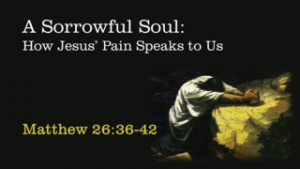PEACE BE WITH YOU
USING SCRIPTURE TO ADDRESS SPIRITUAL DISTRESS AT THE END OF LIFE
For ten years, I have ministered in urban areas as a hospital chaplain (initially in Atlanta, but subsequently – and predominantly – in center-city Philadelphia). My first “parish” units were an oncology ICU in a children’s hospital and a neuroscience ICU in a level-one trauma center general hospital. I have spent the past five years serving the oncology and bone marrow transplant units of the aforementioned general hospital. During that time, I have come to believe that not only must a chaplain be highly skilled at employing quality “ministry of presence” behaviors, but also s/he must be adept at providing scriptural tools and texts to help individuals suffering from spiritual distress.
The term “spiritual distress” first came to my attention when I began working with our Palliative Care specialists as the chaplain liaison for their interdisciplinary team (IDT) meetings. The term itself seemed straight-forward enough to me; what eluded me was how I (or any minister) ought to approach an individual’s spiritual distress. I felt as though the other members of the Palliative Care IDT group were looking to me for answers, of which I had none. Naturally, I subsequently began to ask myself, “When a person is identified as being in ‘spiritual distress,’ what can I do to assist him/her? What should I do? What is the best, most helpful way to minister to a person who knows his/her cancer diagnosis is terminal, who realizes time is limited, and who has grown particularly anxious as a result of this reality?”
After wrestling with various psychological, person-centered theories, an epiphany occurred: perhaps the best way to address spiritual distress is through proactive ministerial presence and the incorporation of Scripture into pastoral visits. This may sound obvious to an ingénue, but seasoned chaplains tend to fall into a rhythm or pattern synchronous with the clinical pastoral education model – which essentially trains ministers to focus whole-heartedly on developing their “ministry of presence” skills and avoid the use of Scripture and prayer in average visits.[1] Thus, my study sought to honor the CPE model of chaplaincy while considering additional approaches to chaplain ministry that would be more helpful for individuals confronting their own mortality due to a terminal cancer diagnosis. My ultimate ministerial goal was to determine a way (or ways) to permit resolution of spiritual anxiety and to assist certain patients in attaining a semblance of peace before drawing their last breath.
Naturally, hospital chaplaincy involves an interfaith approach to ministry. However, for the purpose of this study I focused on individuals with metastatic, terminal cancer being cared for by our Palliative Care team on an inpatient basis, who have self-identified as Christian (either Catholic or Protestant). This seemed to me to be a natural set of parameters, given that I am an ordained Protestant Christian minister serving as the Pastoral Care liaison to the hospital’s Palliative Care team, and given that the highest percentage of patients (by far) for whom Palliative Care is consulted are oncology patients. The thought of attempting to pinpoint Scripture that would help patients who were Muslim, Jewish, Buddhist, etc. seemed far too broad a scope and insurmountable a task. And, additionally, a personal aspect of this project was for me to become more assertive in offering a specific form of spiritual care that involved sharing my own moderate biblical fluency with individuals who are likely much less familiar with Scripture, and for whom Scripture could be the balm for their spiritual distress.
In the beginning phase of my study, I attempted to draw up a “blueprint” of sorts for one specific text that might be utilized in all circumstances (just as certain texts tend to be used in church every Christmas or Easter). However, I quickly found this to be an insufficient approach in ministering to a variety of individuals with a wide array of emotional / spiritual needs. Surprisingly to me, my background of teaching students with specials needs bubbled to the surface, and among the skills I found to be most helpful were my abilities to assess people’s spiritual “strengths” or “gifts.” Using my familiarity with developing Individualized Educational Programs / Plans (IEPs) for students, I created Individualized Scripture Plans (ISPs) for each patient.
The ISP I developed for each individual hinged on her/his unique spiritual, emotional, and even social needs. Ministerially speaking, I felt convicted that the best – if not only – way to honor someone’s dying needs was to be critically attentive to her/his personal expressions, interests, beliefs, and desires. I selected fourteen patient case studies, created a biblical pseudonym for each based on his/her emotional affect, and relied on my own instinctive deductions made from the first two encounters I had had with each to help me select specific scriptural passages.[2] Vanderbilt Divinity Library’s Revised Common Lectionary became a consistent reference point for me, for each patient.[3] The passage ultimately chosen for each patient (from the lectionary options) was based on my asking myself, “Which text will resonate most closely, deeply, and profoundly with this person?” This approach was/is admittedly intuitive in nature and does not necessarily follow a specific methodology. However, I cannot conceive of any alternate approach that would have honored each person’s needs as well as this did.
I decided to highlight five cases in particular. The biblical pseudonyms I created for these patients were Leah, Miriam, Gemariah, Cyrus, and Abigail. These names were not selected randomly; rather, I deliberately chose names that seemed to resonate with their personalities. Leah was my first case study – the one with whom I realized that Scripture is not a “one size fits all” endeavor but rather requires an ISP for each individual. Leah’s passage was the Garden of Gethsemane (Matt 26:36-42). And she seemed comforted by the comparison of her suffering to that of Jesus.
I also spent time with a dynamic woman to whom I refer at Miriam – a professional dancer in her younger years. Reading a passage from Exodus 15 (in addition to the medical care she received) seemed to lift her spirits by leaps and bounds. In the few weeks I knew her, she transformed from a sullen woman confined to her bed, into a vision of grace who seemed to walk nearly effortlessly down the halls.
Someone I call Gemariah seemed to blossom like a cactus flower after I read a portion of Psalm 147 to him and his family, then prayed with them about the beauty and blessings in their family. I will never forget the scene: like disciples gathered around the dying man’s bed, gleaning wisdom from him during his last days of life, we all listened attentively as he began sharing what he knew of early Ancient Near Eastern religions and that, during the past two years as he drove to and from chemo treatments, he had listened to an audio version of the entire Bible a minimum of two times, probably more.
Cyrus was a fascinating man of 65 years with a fairly well-informed interfaith view of the world. I opted to read parts of Ecclesiastes 3 to him, which truly made him ecstatic. One could say he “lit up like a Christmas tree” at its reading.
Finally, Abigail was an absolutely beautiful spirit – a world-traveler, born in northern California, highly motivated and ambitious, who struggled with her own self and the way she vacillated between asking God, “Why me?” and, “How can I use my situation to help others?” Knowing that her diagnosis involved the devastating prognosis every glioblastoma delivers, I spent countless hours with her, trying to help her process her situation on her own terms. I finally determined that sections from Paul’s second letter to the community of Corinth might be helpful for her to hear. I believe that was an accurate assessment, based on her tears, her nodding along, her body language, her hug, and various things she shared thereafter.
It is significant to note that every aspect of this study is specific to this level-one trauma center teaching hospital in center-city Philadelphia, which is also an ACPE-accredited CPE site. I generally utilized either NRSV or NIV Bible interpretations. I would read the given, pre-determined passage aloud to the patient, often repeating parts of the text (or even the entire text) in order to add emphasis. A final noteworthy consideration is that the majority of the case studies transpired during the Advent season, which I believe could have impacted each individual’s receptivity to hearing Scripture being read to them (even if sub- or unconsciously).
Although it may have been helpful for anyone reading this blog if I had included video-recordings of some of my encounters, in the end (after much internal struggle and debate on my part), I determined that recordings could (or would) feel like an invasion of privacy, compromising the trust I had established, and thus decided not to do so.
Perhaps the most invaluable lesson I learned from this process is that the hospital chaplain may very well be the only minister a dying person has at this critical juncture in her/his life. Thus, the chaplain may be the one-and-only person capable of helping her/him become emotionally, mentally, and spiritually ready for death. It is possible that a chaplain can help individuals achieve internal peace by assisting them in confronting and accepting the reality of their own imminent death. As such, chaplains should be prepared to assist individuals through this process. I mention this overtly because research indicates that chaplains tend to be at risk for “spiritual ‘drift’ [with] dangers of ‘dumbing down the spirit’,” strongly suggesting that chaplains embrace “a more considered engagement [of ministry]…with theological roots and resources.” [4] My study seems to validate this recommendation: I was able to deduce that Scripture seemed of value (that is, patients responded favorably) for approximately 85.4% of the fourteen cases I incorporated into this study.
I also was fortunate to receive direct feedback from the spouse of a patient who died in January, 2018 (“Gemariah”). She reached out to me several times throughout the winter and spring, 2018, to let me know how significant it was that I read Scripture to Gemariah and the family, and how she continues to believe it helped him open up dialogue about his spiritual / religious beliefs – feelings he had kept relatively private prior to my encounters with them. The encounters unintentionally became a vehicle for his self-expression, which in turn seemed to resolve any spiritual distress with which he may have contended. I had hoped to capture some of our dialogues on video, but pausing to ask permission to record something always seemed like interference to the conversation, so I never did.
Words cannot adequately express the gratitude I feel for this opportunity to stretch my hospital ministries in new and unexpected ways. I believe this growth will have a profound impact on my patient interactions in all future encounters. I hope to broaden my interests by taking these same principles and expanding upon them for non-Christian patients facing end-of-life circumstances. But for the time being, having developed a previously-lacking assertiveness about utilizing Scripture in patient visits has deeply expanded my own understanding of my chaplain ministries. I am extremely grateful.







So, would you describe your relationship with the patients as close, limited, or distant? Or would it be better described as long, or short-term relationships? Wondering if their response was based on your relationship, or their expectation of the duty of the chaplain. I’m wondering this in my own context and if there might be some similarities in our experiences.
Tommy